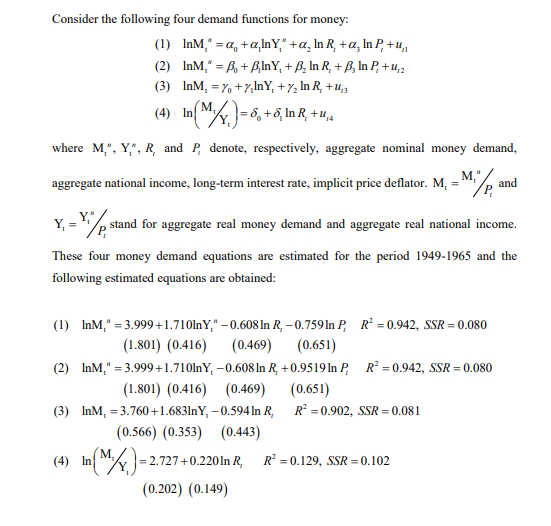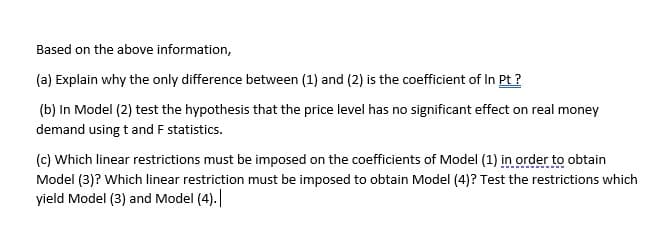Consider the following four demand functions for money: (1) InM, =a, +a̟InY," +a¸ In R_ +a¸ In P,+u, (2) InM," = B, + BInY, + B, In R, + B, In P, + u,2 (3) InM, = 7, +7,InY, + 7, In R, +u,, %3D (4) In M)=5, +5, In R +u,. where M", Y", R and P, denote, respectively, aggregate nominal money demand, and aggregate national income, long-term interest rate, implicit price deflator. M, = M." Y, =2 ,stand for aggregate real money demand and aggregate real national income. These four money demand equations are estimated for the period 1949-1965 and the following estimated equations are obtained: (1) InM," = 3.999+1.710lnY," –0.608 In R, – 0.759In P, R = 0.942, SSR = 0.080 (0.469) (0.651) (1.801) (0.416) (2) InM," = 3.999+1.710lnY, –0.608 In R, +0.9519ln P, R = 0.942, SSR =0.080 (1.801) (0.416) (0.469) (0.651) (3) InM, = 3.760+1.683lnY, – 0.5941n R, R² =0.902, SSR = 0.081 (0.566) (0.353) (0.443) M, (4) In |=2.727+0.220ln R, R =0.129, SSR =0.102 (0.202) (0.149)
Consider the following four demand functions for money: (1) InM, =a, +a̟InY," +a¸ In R_ +a¸ In P,+u, (2) InM," = B, + BInY, + B, In R, + B, In P, + u,2 (3) InM, = 7, +7,InY, + 7, In R, +u,, %3D (4) In M)=5, +5, In R +u,. where M", Y", R and P, denote, respectively, aggregate nominal money demand, and aggregate national income, long-term interest rate, implicit price deflator. M, = M." Y, =2 ,stand for aggregate real money demand and aggregate real national income. These four money demand equations are estimated for the period 1949-1965 and the following estimated equations are obtained: (1) InM," = 3.999+1.710lnY," –0.608 In R, – 0.759In P, R = 0.942, SSR = 0.080 (0.469) (0.651) (1.801) (0.416) (2) InM," = 3.999+1.710lnY, –0.608 In R, +0.9519ln P, R = 0.942, SSR =0.080 (1.801) (0.416) (0.469) (0.651) (3) InM, = 3.760+1.683lnY, – 0.5941n R, R² =0.902, SSR = 0.081 (0.566) (0.353) (0.443) M, (4) In |=2.727+0.220ln R, R =0.129, SSR =0.102 (0.202) (0.149)
Chapter20: Monetary Policy
Section: Chapter Questions
Problem 4SQP
Related questions
Question

Transcribed Image Text:Consider the following four demand functions for money:
(1) InM," = a, +a,InY," +a, In R, + a, In P, + ,
%3D
(2) InM," = B, + BInY, + B, In R, + B, In P, + u,2
(3) InM, = %, +7,InY, + 7, In R, +u,,
(4) InM)=6, +6, InR, +u,.
where M,", Y,", R, and P, denote, respectively, aggregate nominal money demand,
M,",
and
/P,
aggregate national income, long-term interest rate, implicit price deflator. M,
Y, = /
stand for aggregate real money demand and aggregate real national income.
These four money demand equations are estimated for the period 1949-1965 and the
following estimated equations are obtained:
(1) InM," = 3.999+1.710lnY," – 0.608 In R, – 0.759In P, R = 0.942, SSR = 0.080
(0.469)
(1.801) (0.416)
(0.651)
(2) InM," = 3.999+1.710lnY, –0.608In R, +0.9519 In P, R² =0.942, SSR = 0.080
(1.801) (0.416) (0.469)
(0.651)
R = 0.902, SSR = 0.081
(3) InM, = 3.760 +1.683lnY, – 0.594 In R,
(0.566) (0.353) (0.443)
(4) In M)=2.727+0.2201n R,
R = 0.129, SSR = 0.102
(0.202) (0.149)

Transcribed Image Text:Based on the above information,
(a) Explain why the only difference between (1) and (2) is the coefficient of In Pt ?
(b) In Model (2) test the hypothesis that the price level has no significant effect on real money
demand using t and F statistics.
(c) Which linear restrictions must be imposed on the coefficients of Model (1) in order to obtain
Model (3)? Which linear restriction must be imposed to obtain Model (4)? Test the restrictions which
yield Model (3) and Model (4).
Expert Solution
This question has been solved!
Explore an expertly crafted, step-by-step solution for a thorough understanding of key concepts.
Step by step
Solved in 3 steps

Knowledge Booster
Learn more about
Need a deep-dive on the concept behind this application? Look no further. Learn more about this topic, economics and related others by exploring similar questions and additional content below.Recommended textbooks for you







Exploring Economics
Economics
ISBN:
9781544336329
Author:
Robert L. Sexton
Publisher:
SAGE Publications, Inc


Brief Principles of Macroeconomics (MindTap Cours…
Economics
ISBN:
9781337091985
Author:
N. Gregory Mankiw
Publisher:
Cengage Learning